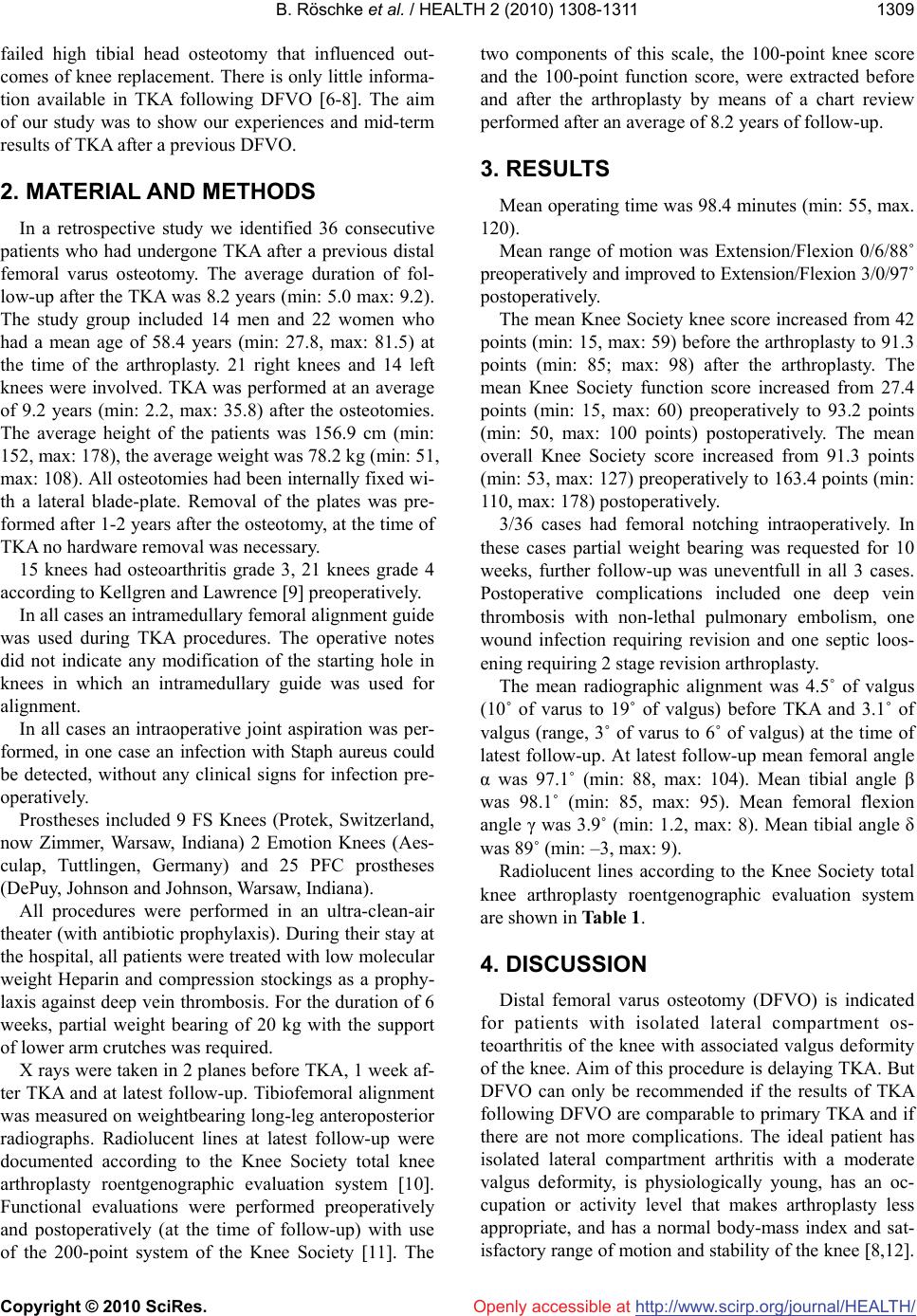
B. Röschke et al. / HEALTH 2 (2010) 1308-1311
Copyright © 2010 SciRes. http://www.scirp.org/journal/HEALTH/Openly accessible at
1309
failed high tibial head osteotomy that influenced out-
comes of knee replacement. There is only little informa-
tion available in TKA following DFVO 6-8. The aim
of our study was to show our experiences and mid-term
results of TKA after a previous DFVO.
2. MATERIAL AND METHODS
In a retrospective study we identified 36 consecutive
patients who had undergone TKA after a previous distal
femoral varus osteotomy. The average duration of fol-
low-up after the TKA was 8.2 years (min: 5.0 max: 9.2).
The study group included 14 men and 22 women who
had a mean age of 58.4 years (min: 27.8, max: 81.5) at
the time of the arthroplasty. 21 right knees and 14 left
knees were involved. TKA was performed at an average
of 9.2 years (min: 2.2, max: 35.8) after the osteotomies.
The average height of the patients was 156.9 cm (min:
152, max: 178), the average weight was 78.2 kg (min: 51,
max: 108). All osteotomies had been internally fixed wi-
th a lateral blade-plate. Removal of the plates was pre-
formed after 1-2 years after the osteotomy, at the time of
TKA no hardware removal was necessary.
15 knees had osteoarthritis grade 3, 21 knees grade 4
according to Kellgren and Lawrence 9 preoperatively.
In all cases an intramedullary femoral alignment guide
was used during TKA procedures. The operative notes
did not indicate any modification of the starting hole in
knees in which an intramedullary guide was used for
alignment.
In all cases an intraoperative joint aspiration was per-
formed, in one case an infection with Staph aureus could
be detected, without any clinical signs for infection pre-
operatively.
Prostheses included 9 FS Knees (Protek, Switzerland,
now Zimmer, Warsaw, Indiana) 2 Emotion Knees (Aes-
culap, Tuttlingen, Germany) and 25 PFC prostheses
(DePuy, Johnson and Johnson, Warsaw, Indiana).
All procedures were performed in an ultra-clean-air
theater (with antibiotic prophylaxis). During their stay at
the hospital, all patients were treated with low molecular
weight Heparin and compression stockings as a prophy-
laxis against deep vein thrombosis. For the duration of 6
weeks, partial weight bearing of 20 kg with the support
of lower arm crutches was required.
X rays were taken in 2 planes before TKA, 1 week af-
ter TKA and at latest follow-up. Tibiofemoral alignment
was measured on weightbearing long-leg anteroposterior
radiographs. Radiolucent lines at latest follow-up were
documented according to the Knee Society total knee
arthroplasty roentgenographic evaluation system 10.
Functional evaluations were performed preoperatively
and postoperatively (at the time of follow-up) with use
of the 200-point system of the Knee Society 11. The
two components of this scale, the 100-point knee score
and the 100-point function score, were extracted before
and after the arthroplasty by means of a chart review
performed after an average of 8.2 years of follow-up.
3. RESULTS
Mean operating time was 98.4 minutes (min: 55, max.
120).
Mean range of motion was Extension/Flexion 0/6/88˚
preoperatively and improved to Extension/Flexion 3/0/97˚
postoperatively.
The mean Knee Society knee score increased from 42
points (min: 15, max: 59) before the arthroplasty to 91.3
points (min: 85; max: 98) after the arthroplasty. The
mean Knee Society function score increased from 27.4
points (min: 15, max: 60) preoperatively to 93.2 points
(min: 50, max: 100 points) postoperatively. The mean
overall Knee Society score increased from 91.3 points
(min: 53, max: 127) preoperatively to 163.4 points (min:
110, max: 178) postoperatively.
3/36 cases had femoral notching intraoperatively. In
these cases partial weight bearing was requested for 10
weeks, further follow-up was uneventfull in all 3 cases.
Postoperative complications included one deep vein
thrombosis with non-lethal pulmonary embolism, one
wound infection requiring revision and one septic loos-
ening requiring 2 stage revision arthroplasty.
The mean radiographic alignment was 4.5˚ of valgus
(10˚ of varus to 19˚ of valgus) before TKA and 3.1˚ of
valgus (range, 3˚ of varus to 6˚ of valgus) at the time of
latest follow-up. At latest follow-up mean femoral angle
α was 97.1˚ (min: 88, max: 104). Mean tibial angle β
was 98.1˚ (min: 85, max: 95). Mean femoral flexion
angle γ was 3.9˚ (min: 1.2, max: 8). Mean tibial angle δ
was 89˚ (min: –3, max: 9).
Radiolucent lines according to the Knee Society total
knee arthroplasty roentgenographic evaluation system
are shown in Table 1.
4. DISCUSSION
Distal femoral varus osteotomy (DFVO) is indicated
for patients with isolated lateral compartment os-
teoarthritis of the knee with associated valgus deformity
of the knee. Aim of this procedure is delaying TKA. But
DFVO can only be recommended if the results of TKA
following DFVO are comparable to primary TKA and if
there are not more complications. The ideal patient has
isolated lateral compartment arthritis with a moderate
valgus deformity, is physiologically young, has an oc-
cupation or activity level that makes arthroplasty less
appropriate, and has a normal body-mass index and sat-
isfactory range of motion and stability of the knee 8,12].